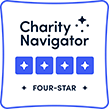Sponsored Content:
This content is not an endorsement from the ABTA.
Sponsored by Novocure® *

For Kate, life’s challenges were always opportunities to learn and grow. But her philosophy and resilience were tested when she was diagnosed with glioblastoma (GBM). And yet, after her diagnosis, as with every transition in her life, Kate found she was given—if not what she wanted—what she needed to move forward. In honor of Brain Tumor Awareness Month, Kate wants to share her story with you.
Acceptance Opens the Door for Embracing Life’s Gifts
A career in the Navy taught me that as hard as something may be and as much as I may not understand it at the time, in some strange way, those difficult experiences in life are always exactly what I need when I need it.
Throughout my life, this lesson has held true. For decades, my husband Pat and I had adventures together as we worked, traveled, and raised our sons. Life wasn’t always easy, but it provided what we needed at every turn. And then, one day, life took a sharp turn that we had not planned and could not have prepared for.
While on a road trip with Pat, I began to notice a sudden change in my vision. At first, I blamed the problem on my new glasses, but after seeing an eye doctor, I discovered that both of the right top quadrants of my sight were gone. The ophthalmologist thought I’d had a stroke and sent me back to see my doctor immediately.
At this point, I had an MRI and things unfolded quickly. My doctor contacted one of the top neurosurgeons in Seattle to meet with us to go over the MRI results the next day. I had a feeling we weren’t about to get good news. When the neurosurgeon said, “glioblastoma,” I pretty much said, “Ahhhh, shoot.” The neurosurgeon threw around words like “terminal” and “life expectancy.” Pat and I aren’t ones to fall apart and weep and wail, but the diagnosis was certainly disappointing. After my diagnosis was confirmed with a biopsy, once again, I’d been given what I needed, exactly when I needed it!
One of our daughters-in-law researched GBM and its treatments and learned about Optune. We read that Optune is a wearable, portable, FDA-approved treatment for GBM in adult patients. When we talked with my oncologist, he said that he had been thinking of Optune for me, too. He went over the importance of using Optune at least 75 percent of the time, which equals 18 hours per day, and we discussed the potential side effects. From that point on, we were totally focused on Optune.
Then it came time to shave my head…I never realized that my hair was a bit more of my identity than I thought it was. Thankfully, I had the support of Pat, our children, my sisters, and the encouragement of nCompassTM, a support program provided by Novocure. They were (and are) awesome! A Device Support Specialist (DSS) came to our home and was calm and thorough as we all learned how to apply my arrays.
I’ll admit—getting used to Optune took a little bit of time, but now it feels like part of my life. I do a lot of the things I’ve always done, like go to soccer games, spend time with my sisters, and have adventures with Pat.
Living with GBM isn’t easy. Actually, there are times when it’s really hard. We don’t know what the future holds, but I share my story with you hoping that in some small way, your being here is exactly what you need when you need it, too.

*Kate is an Optune user and a Patient Ambassador. Pat is a Caregiver Ambassador.
What is Optune® approved to treat?
Optune is a wearable, portable, FDA-approved device indicated to treat a type of brain cancer called glioblastoma multiforme (GBM) in adult patients 22 years of age or older.
Newly diagnosed GBM
If you have newly diagnosed GBM, Optune is used together with a chemotherapy called temozolomide (TMZ) if:
- Your cancer is confirmed by your healthcare professional AND
- You have had surgery to remove as much of the tumor as possible
Recurrent GBM
If your tumor has come back, Optune can be used alone as an alternative to standard medical therapy if:
- You have tried surgery and radiation and they did not work or are no longer working AND
- You have tried chemotherapy and your GBM has been confirmed by your healthcare professional
Who should not use Optune?
Optune is not for everyone. Talk to your doctor if you have:
- An implanted medical device (programmable shunt), skull defect (missing bone with no replacement), or bullet fragment. Optune has not been tested in people with implanted electronic devices, which may cause the devices not to work properly, and Optune has not been tested in people with skull defects or bullet fragments, which may cause Optune not to work properly
- A known sensitivity to conductive hydrogels (the gel on the arrays placed on the scalp like the ones used on EKGs). When Optune comes into contact with the skin, it may cause more redness and itching or may rarely cause a life-threatening allergic reaction
Do not use Optune if you are pregnant or are planning to become pregnant. It is not known if Optune is safe or effective during pregnancy.
What should I know before using Optune?
Optune should only be used after receiving training from qualified personnel, such as your doctor, a nurse, or other medical staff who have completed a training course given by Novocure®, the maker of Optune.
- Do not use any parts that did not come with the Optune Treatment Kit sent to you by Novocure or given to you by your doctor
- Do not get the device or transducer arrays wet
- If you have an underlying serious skin condition on the scalp, discuss with your doctor whether this may prevent or temporarily interfere with Optune treatment
What are the possible side effects of Optune
Most common side effects of Optune when used together with chemotherapy (temozolomide, or TMZ) were low blood platelet count, nausea, constipation, vomiting, tiredness, scalp irritation from the device, headache, seizure, and depression. The most common side effects when using Optune alone were scalp irritation (redness and itchiness) and headache. Other side effects were malaise, muscle twitching, fall and skin ulcers. Talk to your doctor if you have any of these side effects or questions.
Please visit Optune.com/Safety for the Optune Instructions For Use (IFU) for complete information regarding the device’s indications, contraindications, warnings, and precaution.
©2021 Novocure GmbH. All rights reserved. Optune, Novocure and nCompass are trademarks of Novocure. US-OPT-04361 March 2021














